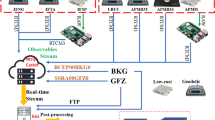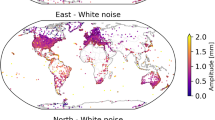Abstract
We present an analytical relationship between the high-low satellite-to-satellite tracking measurement errors and the accuracy of the gravity field recovery from the point of view of signal theory, which concerns the field where geodesy is in contact with physics and technical sciences. This method enables us to gain a better understanding of the effects of the instrument noise and the mission parameters on the gravity field recovery directly, especially for the analysis of the noise spectral characteristics. It is a helpful tool for the pre-mission analysis before full-scale simulations are conducted. By taking the advantage of the analytical expression, this study discusses how the orbit errors and accelerometer noise degrade the accuracy of the gravity field recovery from high-low satellite-to-satellite tracking observations. The results show that the noise level of orbit errors is at least one to four orders of magnitude larger than that of accelerometers in the measurement bandwidth with the state-of-the-art technologies, which indicates that the accuracy of the gravity field coefficients is mainly limited by the level of orbit errors for high-low satellite-to-satellite tracking observations.
Similar content being viewed by others
References
Arsov K. and Pail R., 2003. Assessment of two methods for gravity field recovery from GOCE GPS-SST orbit solutions. Adv. Geosci., 1, 121–126.
Baur O., Reubelt T., Weigelt M., Roth M. and Sneeuw N., 2012. GOCE orbit analysis: Long-wavelength gravity field determination using the acceleration approach. Adv. Space Res., 50, 385–396, DOI: 10.1016/j.asr.2012.04.022.
Cai L., Zhou Z., Zhu Z., Gao F. and Hsu H., 2012. Spectral analysis for recovering the Earth’s gravity potential by satellite gravity gradients. Chinese J. Geophys., 55, 1565–1571.
Cai L., Zhou Z., Hsu H., Gao F., Zhu Z. and Luo J., 2013a. Analytical error analysis for satellite gravity field determination based on two-dimensional Fourier method. J. Geodesy, 87, 417–426, DOI: 10.1007/s00190-013-0615-6.
Cai L., Zhou Z., Gao F. and Luo J., 2013b. Lunar gravity gradiometry and requirement analysis. Adv. Space Res., 52, 715–722, DOI: 10.1016/j.asr.2013.04.009.
Colombo O.L., 1981. Numerical Methods for Harmonic Analysis on the Sphere. Report 310. Department of Geodetic Science, The Ohio State University, Columbus, OH.
Colombo O.L., 1986. Ephemeris errors of GPS satellites. Bull Geod., 60, 64–84. DOI: 10.1007/BF02519355.
Ditmar P., Visser P. and Klees R., 2003. On the joint inversion of SGG and SST data from the GOCE mission. Adv. Geosci., 1, 87–94, DOI: 10.5194/adgeo-1-87-2003.
ESA, 1999. The Four Candidate Earth Explorer Core Missions — Gravity Field and Steady-State Ocean Circulation Mission. ESA Report SP-1233(1), ESA Publications Division, c/o ESTEC, Noordwijk, The Netherlands.
Frommknecht B., 2007. Integrated Sensor Analysis of the GRACE Mission. Ph.D. Thesis. Institute for Astronomical and Physical Geodesy, Technical University Munich, Munich, Germany.
Gerlach C., Földvary L., Švehla D., Gruber T., Wermuth M., Sneeuw N., Frommknecht B., Oberndorfer H., Peters T. and Rothacher M., 2003. A CHAMP-only gravity field model from kinematic orbits using the energy integral. Geophys. Res. Lett., 30, 2037.
Gruber C., Novák P. and Sebera J., 2011. FFT-based high-performance spherical harmonic transformation. Stud. Geophys. Geod., 55, 489–500, DOI: 10.1007/s11200-011-0029-y.
Heiskanen W.A. and Moritz H., 1967. Physical geodesy. Bull. Geod., 86, 491–492, DOI: 10.1007/BF02525647.
Jäggi A., Bock H., Prange L., Meyer U. and Beutler G., 2011. GPS-only gravity field recovery with GOCE, CHAMP, and GRACE. Adv. Space Res., 47, 1020–1028, DOI: 10.1016/j.asr.2010.11.008.
Jekeli C., 1999. The determination of gravitational potential differences from satellite-to-satellite tracking. Celest. Mech. Dyn. Astron., 75, 85–101, DOI: 10.1023/A:1008313405488.
Josselin V., Touboul P. and Kielbasa R., 1999. Capacitive detection scheme for space accelerometers applications. Sens. Actuator A-Phys., 78, 92–98, DOI: 10.1016/S0924-4247(99)00227-7.
Kim J., 2000. Simulation Sstudy of a Low-Low Satellite-to-Satellite Tracking Mission. Ph.D. Thesis. The University of Texas at Austin, Austin, TX.
Koop R., 1993. Global Gravity Field Modelling Using Satellite Gravity Gradiometry. Publications on Geodesy, New Series 38. Netherlands Geodetic Commission, Delft, The Netherlands.
Migliaccio F., Reguzzoni M. and Sanso F., 2004. Space-wise approach to satellite gravity field determination in the presence of coloured noise. J. Geodesy, 78, 304–313, DOI: 10.1007/s00190-004-0396-z.
Ogata K., 2010. Modern Control Engineering. Prentice Hall, Upper Saddle River, NJ.
Pail R., Goiginger H., Schuh W.D., Hock E., Brockmann J.M., Fecher T., Gruber T., Mayer-Gürr T., Kusche J., Jaggi A. and Rieser D., 2010. Combined satellite gravity field model GOCO01S derived from GOCE and GRACE. Geophys. Res. Lett., 37, L20314, DOI: 10.1029/2010GL044906.
Perosanz F., Biancale R., Loyer S., Lemoine J.-M., Perret A., Touboul P., Foulon B., Pradels G., Grunwald L., Fayard T., Vales N. and Sarrailh M., 2003. On board evaluation of the STAR accelerometer. In: Reigber C., Luhr H. and Schwintzer P. (Eds), First CHAMP Mission Results for Gravity, Magnetic and Atmospheric Studies. Springer-Verlag, Berlin, Heidelberg, Germany, 11–18, DOI: 10.1007/978-3-540-38366-6_2.
Reigber C., Balmino G., Schwintzer P., Biancale R., Bode A., Lemoine J.-M., Konig R., Loyer S., Neumayer H., Marty J.-C., Barthelmes F., Perosanz F. and Zhu S.Y., 2002. A high-quality global gravity field model from CHAMP GPS tracking data and accelerometry (EIGEN-1S). Geophys. Res. Lett., 29, 1692, DOI: 10.1029/2002GL015064.
Reigber C., Schwintzer P., Neumayer K.H., Barthelmes F., König R., Förste C., Balmino G., Biancale R., Lemoine J.M., Loyer S., Bruinsma S., Perosanz F. and Fayard T., 2003. The CHAMP-only earth gravity field model EIGEN-2. Adv. Space Res., 31, 1883–1888, DOI: 10.1016/S0273-1177(03)00162-5.
Schrama E.J.O., 1989. TheRrole of Orbit Errors in Processing Satellite Altimeter Data. Publications on Geodesy 33, Netherlands Geodetic Commission, Delft, The Netherlands.
Schrama E.J.O., 1991. Gravity field error analysis: Applications of global positioning system receivers and gradiometers on low orbiting platforms. J. Geophys. Res., 96(B12), 20041–20051, DOI: 10.1029/91JB01972.
Schwintzer P., Kang Z. and Perosanz F., 2000. Accelerometry aboard CHAMP. In: Rummel R., Drewes H., Bosch W. and Hornik H. (Eds), Towards an Integrated Global Geodetic Observing System (IGGOS). International Association of Geodesy Symposia 120, Springer-Verlag, Berlin, Heidelberg, Germanz, 197–200, DOI: 10.1007/978-3-642-59745-9_39.
Sneeuw N., 2000. A semi-analytical approach to gravity field analysis from satellite observations. DGK Series C, No. 527, Verlag der Bayerischen Akademie der Wissenschaften, ISBN (Print) 3-7696-9566-6, ISSN 0065-5325.
Tapley B.D., Bettadpur S., Watkins M. and Reigber C., 2004. The gravity recovery and climate experiment: Mission overview and early results. Geophys. Res. Lett., 31, L09607, DOI: 10.1029/2004GL019920.
Touboul P., 2001. Space accelerometers: present status. In: Lammerzahl C., Everitt C.W.F. and Hehl F. (Eds), Gyros, Clocks, Interferometers...: Testing Relativistic Graviy in Space. Lecture Notes in Physics 562. Springer-Verlag, Berlin, Heidelberg, Germany, 273–291, DOI: 10.1007/3-540-40988-2_13.
Touboul P., Willemenot E., Foulon B. and Josselin V., 1999. Accelerometers for CHAMP, GRACE and GOCE space missions: synergy and evolution. Bollettino di Geofisica Teorica e Applicata, 40, 321–327.
Visser P.N.A.M., Sneeuw N. and Gerlach C., 2003. Energy integral method for gravity field determination from satellite orbit coordinates. J. Geodesy, 77, 207–216, DOI: 10.1007/s00190-003-0315-8.
Author information
Authors and Affiliations
Corresponding author
Rights and permissions
About this article
Cite this article
Cai, L., Zhou, Z. & Luo, J. Analytical method for error analysis of high-low satellite-to-satellite tracking missions. Stud Geophys Geod 59, 380–393 (2015). https://doi.org/10.1007/s11200-014-0153-6
Received:
Revised:
Accepted:
Published:
Issue Date:
DOI: https://doi.org/10.1007/s11200-014-0153-6




